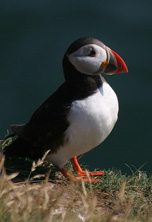|  English
Nature has developed its maritime strategy to help implement Government’s
stewardship vision set out in ‘Safeguarding
our Seas’ and address some of the issues raised in Defra’s
recent report ‘Charting
Progress: An Integrated Assessment of the State of UK Seas’. English
Nature has developed its maritime strategy to help implement Government’s
stewardship vision set out in ‘Safeguarding
our Seas’ and address some of the issues raised in Defra’s
recent report ‘Charting
Progress: An Integrated Assessment of the State of UK Seas’.
This strategy highlights the need for action across a range of
issues from the loss of coastal habitats due to coastal squeeze
to the damage to our marine ecosystem caused by over-exploitation
of fisheries. We highlight the need to adapt to coastal change by
completing the shift from coastal defence to coastal management,
and advocate the establishment of a marine spatial planning system
and a coherent network of Marine Protected Areas. We set out actions
to achieve these aims using different spatial scales ranging from
local through regional to national and international. We have adopted
this approach because ecosystems and systems of governance work
at a range of spatial scales and because this approach relates to
how most people view and use our coasts and seas.
Three key priorities for action highlighted in our Maritime Strategy
are;
| 1. |
The need for new legislation to take
forward a network of Marine Protected Areas that represents
all habitats and species. Such a network will include
some areas that are highly protected to stop all damaging commercial
and recreational activities. The network of Marine Protected
Areas will contribute to the recovery and protection of the
whole marine ecosystem which will bring multiple benefits. It
will allow exploited species to recover which can lead to bigger
fish catches; a healthier environment that is more resilient
to change; and greater protection to both common and rare species.
To deliver these benefits, at least 20-30% of all marine habitats
will need to have strict protection from damaging impacts. Elsewhere,
improved sustainable management of on-going activities will
also be required. |
 |
| 2. |
Moving from coastal defence to coastal
management. Our coasts are constantly changing. We
need more innovative management working with coastal processes
to create the space for coastal habitats and geodiversity. This
will allow coastal habitats and their wildlife to adapt and
move offering greater protection, conservation and opportunities
for sustainable tourism. |
 |
| 3. |
Marine spatial planning. As
the sea becomes increasingly congested there is a growing need
to balance often conflicting marine uses while protecting and
managing the marine environment. Currently there is no overview
of new applications for potentially harmful activities in our
seas. Individually each may not be harmful but together there
can be problems. This would be addressed by co-ordinated and
effective spatial planning. |
|

